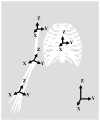Upper-limb joint kinetics expression during wheelchair propulsion
- PMID: 20104416
- PMCID: PMC2857327
- DOI: 10.1682/jrrd.2008.12.0165
Upper-limb joint kinetics expression during wheelchair propulsion
Abstract
In the wheelchair propulsion literature, it is common to report upper-limb (UL) joint kinetics to express shoulder, elbow, and wrist loads. Choosing the appropriate kinetic resolution coordinate system (CS) for UL joint forces and moments has become a laboratory-specific process. The differences that arise during interpretation may hinder a clear and broad understanding of UL joint kinetics during wheelchair propulsion. This article addresses the inconsistency of kinetic reporting in the wheelchair literature that examines the pain and injury experienced by manual wheelchair users. To highlight the variety of reporting methods in wheelchair propulsion, this article surveys peer-reviewed, published articles reporting wrist-, elbow-, or shoulder-joint intersegmental forces and moments calculated from inverse dynamics during wheelchair propulsion. To correct this inconsistency, researchers may need to standardize kinetic reporting methods to achieve a cohesive comprehension of wheelchair biomechanics. This article is provided to open discussion on the anatomical and clinical relevance of currently employed CSs and other available options, with the additional goal of providing an initial recommendation for kinetic representation during wheelchair propulsion.
Figures
Similar articles
-
Shoulder pain and jerk during recovery phase of manual wheelchair propulsion.J Biomech. 2015 Nov 5;48(14):3937-44. doi: 10.1016/j.jbiomech.2015.09.018. Epub 2015 Oct 9. J Biomech. 2015. PMID: 26472307 Free PMC article.
-
The Influence of Sex on Upper Extremity Joint Dynamics in Pediatric Manual Wheelchair Users With Spinal Cord Injury.Top Spinal Cord Inj Rehabil. 2021 Fall;27(3):26-37. doi: 10.46292/sci20-00057. Epub 2021 Aug 13. Top Spinal Cord Inj Rehabil. 2021. PMID: 34456544 Free PMC article.
-
A comparison of static and dynamic optimization muscle force predictions during wheelchair propulsion.J Biomech. 2014 Nov 7;47(14):3459-65. doi: 10.1016/j.jbiomech.2014.09.013. Epub 2014 Sep 23. J Biomech. 2014. PMID: 25282075 Free PMC article.
-
Moving forward: A review of continuous kinetics and kinematics during handcycling propulsion.J Biomech. 2023 Oct;159:111779. doi: 10.1016/j.jbiomech.2023.111779. Epub 2023 Aug 30. J Biomech. 2023. PMID: 37703719 Review.
-
Biomechanics and physiology in active manual wheelchair propulsion.Med Eng Phys. 2001 Dec;23(10):713-33. doi: 10.1016/s1350-4533(01)00083-2. Med Eng Phys. 2001. PMID: 11801413 Review.
Cited by
-
Shoulder pain and cycle to cycle kinematic spatial variability during recovery phase in manual wheelchair users: a pilot investigation.PLoS One. 2014 Mar 10;9(3):e89794. doi: 10.1371/journal.pone.0089794. eCollection 2014. PLoS One. 2014. PMID: 24614232 Free PMC article.
-
Feasibility of gestural feedback treatment for upper extremity movement in children with cerebral palsy.IEEE Trans Neural Syst Rehabil Eng. 2013 Mar;21(2):300-5. doi: 10.1109/TNSRE.2012.2227804. Epub 2012 Nov 16. IEEE Trans Neural Syst Rehabil Eng. 2013. PMID: 23193461 Free PMC article. Clinical Trial.
-
Biomechanical impact of elbow motion in elbow stiffness.Int Orthop. 2023 Jul;47(7):1779-1786. doi: 10.1007/s00264-023-05781-2. Epub 2023 Apr 3. Int Orthop. 2023. PMID: 37010561
-
Effects of the racket polar moment of inertia on dominant upper limb joint moments during tennis serve.PLoS One. 2014 Aug 12;9(8):e104785. doi: 10.1371/journal.pone.0104785. eCollection 2014. PLoS One. 2014. PMID: 25117871 Free PMC article.
-
Variability in Wheelchair Propulsion: A New Window into an Old Problem.Front Bioeng Biotechnol. 2015 Jul 27;3:105. doi: 10.3389/fbioe.2015.00105. eCollection 2015. Front Bioeng Biotechnol. 2015. PMID: 26284239 Free PMC article. Review.
References
-
- Gellman H, Sie I, Waters RL. Late complications of the weight-bearing upper extremity in the paraplegic patient. Clin Orthop Relat Res. 1988 Aug;(233):132–5. - PubMed
-
- Wylie EJ, Chakera TM. Degenerative joint abnormalities in patients with paraplegia of duration greater than 20 years. Paraplegia. 1988 Apr;26(2):101–6. - PubMed
-
- Pentland WE, Twomey LT. Upper limb function in persons with long term paraplegia and implications for independence: Part II. Paraplegia. 1994 Apr;32(4):219–24. - PubMed
-
- Bayley JC, Cochran TP, Sledge CB. The weight-bearing shoulder. The impingement syndrome in paraplegics. J Bone Joint Surg Am. 1987 Jun;69(5):676–8. - PubMed
-
- Curtis KA, Drysdale GA, Lanza RD, Kolber M, Vitolo RS, West R. Shoulder pain in wheelchair users with tetraplegia and paraplegia. Archives of Physical Medicine & Rehabilitation. 1999 Apr;80(4):453–7. - PubMed
Publication types
MeSH terms
Grants and funding
LinkOut - more resources
Full Text Sources

